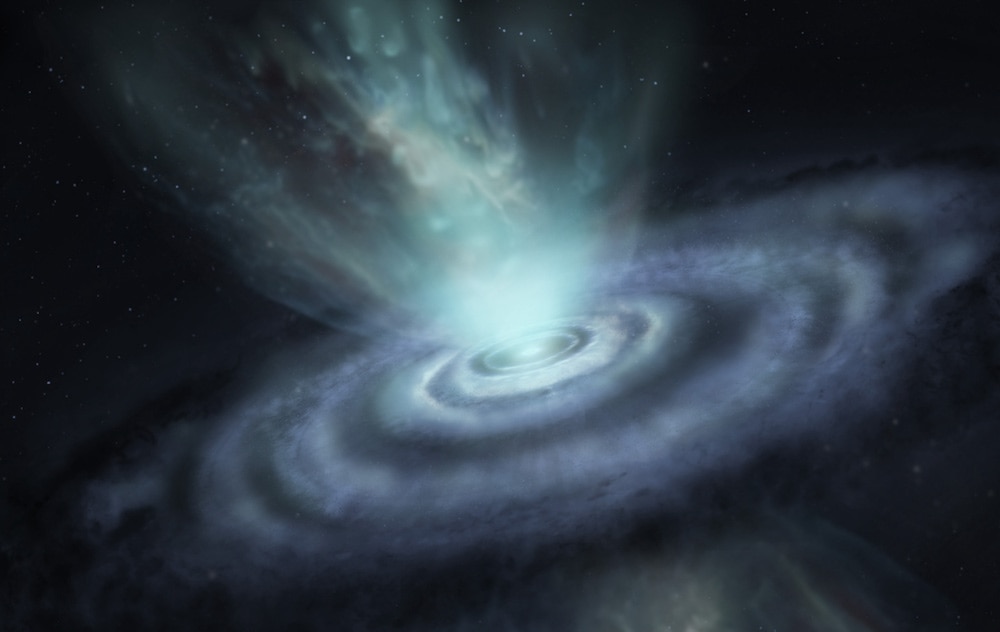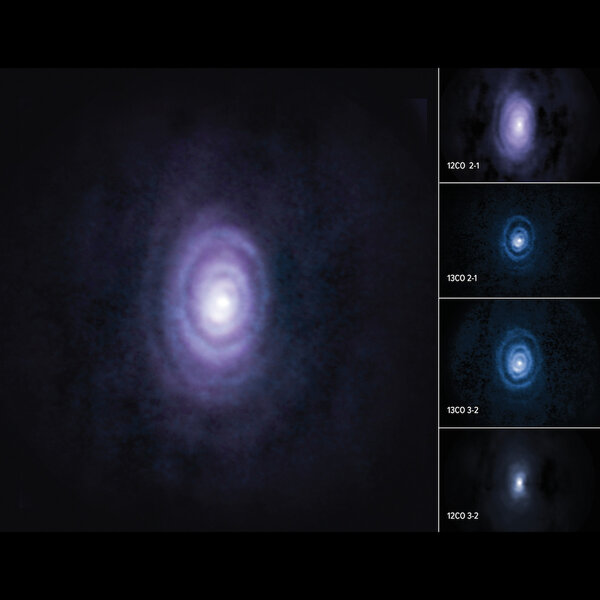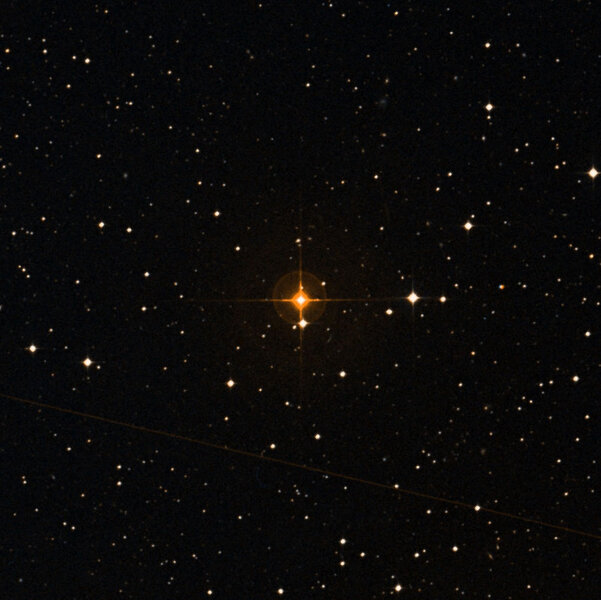Create a free profile to get unlimited access to exclusive videos, sweepstakes, and more!
DUDE, where's my carbon star?
V Hydrae is dying and blowing smoke rings.

The star V Hydrae is dying. But it’s dying with style.
It’s about 1,400 light-years from Earth, and was once similar to the Sun but is now what we call an asymptotic giant branch (or AGB) star: One that has run out of hydrogen fuel in its core to fuse into helium and has swollen up hugely. Stars like this expand and become red giants, and over some millions of years will contract and expand several times, usually getting bigger at each expansion phase.
The last time they do this they get seriously swole, becoming AGB stars. This stage is ephemeral on a cosmic scale, lasting some tens or maybe hundreds of thousands of years. They get so big that the gravity at their surface drops to almost nothing, and they’re so luminous — V Hydrae blasts out light at a rate over 10,000 times the Sun’s — that any molecules at their surface feel a huge force outwards. This causes the star to blow a wind of particles away.
Usually this wind is roughly spherical, expanding away in all directions. But V Hydrae is way cooler than that: New observations using the Atacama Large Millimeter/submillimeter array, or ALMA, show that it’s expelling material in a series of flat rings that are expanding away from the star at a speed of 40,000 kilometers per hour. It’s also blowing out material perpendicular to those rings in narrow cones at much higher speed, too.
It gets even cooler: Every 8.5 years or so, V Hydrae shoots out denser clumps of material called bullets that fly away perpendicular to the disk at over 700,000 km/hr! These bullets have enough gas in them to make over a dozen objects the size of our Moon, so they’re hefty. The energy involved in accelerating that much mass to that speed is phenomenal.
So what’s going on?
Two things, probably [link to paper]. One is that V Hydrae is almost certainly not just one star, but two. It’s a binary. One star is the AGB, blarting out material as it dies. Some of this material gets trapped by the second star’s gravity and forms a disk around it. V Hydrae dims every few years as that disk partially blocks the star from our perspective; that was the first clue it’s a binary. The second star probably orbits the first on an elliptical path, and when it dips closest to the AGB star once every orbit the two interact in such a way to focus the outflow and eject those bullets.
This would also explain why so much of the material the AGB star is blowing out is in a disk, too. If it were alone the matter would expand away in a sphere, but as the two stars orbit each other there’s a centrifugal force component that gives the material a big kick along the plane of that orbit. It’s the same thing as if you had a bucket of water with a hole in the bottom that you then swung around you: The water would fly off in the same plane the bucket spins in.
But why rings? If the material is continuously blown off the AGB star it should form a disk. This is the second thing going on: Most likely the AGB star is experiencing episodic eruptions of material. In other words, it’s not a steady wind, but instead has periods of constant blowing punctuated by short periods of much more intense outflow, like a sudden gust happening on a steadily windy day. These pulses last for some years, creating rings blowing away from the star. Six rings are clearly visible in the ALMA data, and by measuring their velocities and sizes, their ages can be found. They’re young: The innermost ring was ejected about 270 years ago, and then moving outward the rings are 485, 780, 1220, 1470, and 2150 years old, with about a 10-15% uncertainty. Given that stars live for billions of years, that’s the blink of a cosmic eye.
Reading the paper I had to laugh: The astronomers nicknamed this whole structure a Disk Undergoing Dynamical Expansion, or DUDE. One assumes it abides.
Interestingly, a close look at the rings shows they don’t all have the same inclination; they’re a bit tipped relative to one another. That could be due to the second star’s orbit not lining up perfectly with the AGB star’s equator, so that every time a ring is ejected the second star is at a slightly different angle.
I’ll note that V Hydrae is also what we call a carbon star, one with a lot more carbon in its atmosphere than most stars — these stars are very red; I’ve seen a couple through a telescope with my own eyes and they can be shockingly and brilliantly vermilion, like rubies. The carbon is formed in its core and gets dredged up to the surface. As this material cools and gets blown off the star it forms complex molecules made up of chains of carbon atoms… what you may be more familiar with as soot. Astronomers call this material generically dust, and its ejection is similar to what happened to Betelgeuse a few years back which caused it to dim as dust blocked some of the star from our view. Also, that carbon can combine with oxygen to form carbon monoxide, and it’s that gas that ALMA was able to see forming V Hydrae’s rings.
V Hydrae is in a delicate state. It’s dying, certainly, but it’s also in a very short phase of its life called the pre-planetary nebula stage. As more and more material is blown away from it, its size and mass decrease, and the hot core of the star can blow it away faster and faster. The material blowing off perpendicular to the disk, forming the two cones, will become much stronger, growing so much they dwarf the disk, and what we’ll see is an hourglass-shaped structure. When the core is finally exposed the ultraviolet light it will blast out will excite that gas, causing it to glow.
We call such an object a planetary nebula. The one V Hydrae makes will be spectacular, and one of the closer such objects in our sky. Too bad it won’t happen for a few dozen millennia.
Given how short this phase of a star’s life is, it’s exceptional that one this close to us exists and can be studied. It’s wonderful that we have the tools needed to see it in detail and analyze it, too! We can learn a lot about how stars die from this one example, and that’s an important stage in the overall cycle of stellar life in the galaxy. Sad, maybe, but also beautiful and necessary.
And very, very cool.





























